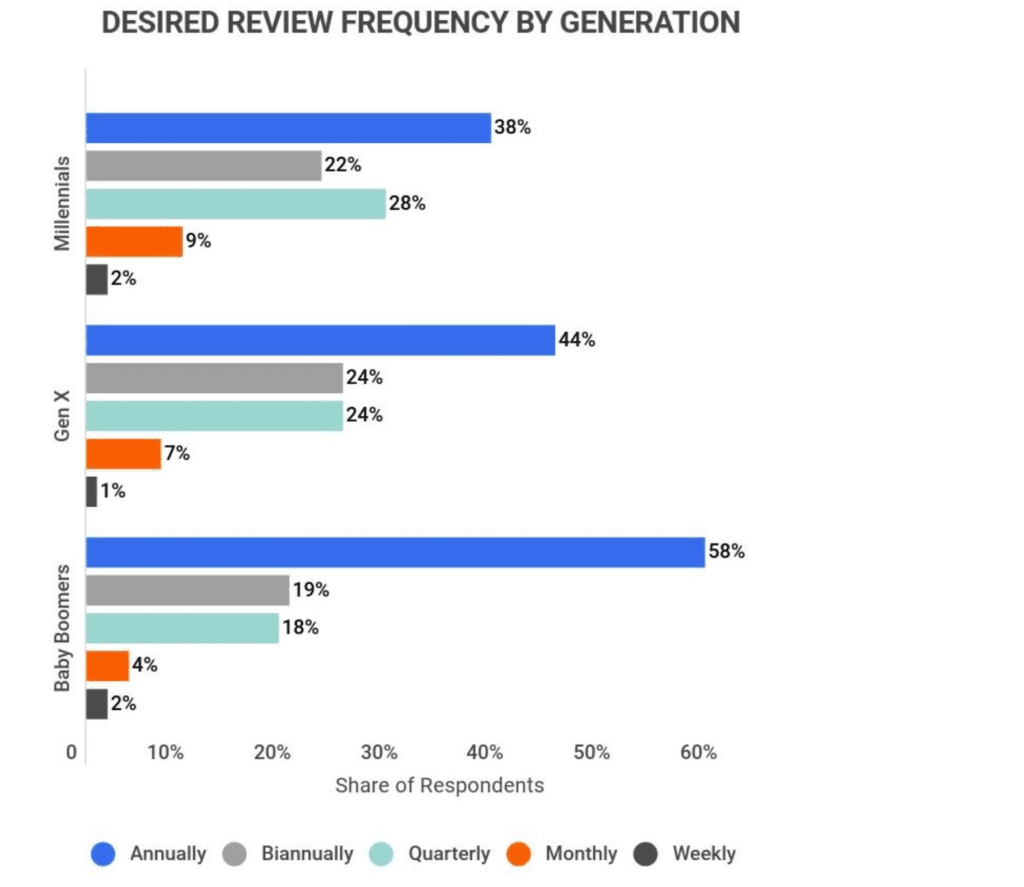Gone are the days when manager feedback and interactions with the workforce were limited to 2 possible topics:
- Whether the quality of work is satisfactory
- Whether all deadlines are met on time

Usually, these interactions were completed within a day through an annual performance review. Unfortunately, 77% of HR executives believe that annual performance reviews don’t accurately represent employee performance. As a result, managers are desperately looking for solutions that can help improve workforce management for their company. Well, studies say that workers are looking for a more collaborative process with regular and qualitative feedback. This blog looks at how managers can give regular and qualitative feedback and improve workforce management in different ways.
Main Elements of Effective Manager Feedback
In business, team feedback is critical for identifying firm goals and tracking success. Feedback should be purposeful, constructive, and engaging in order to be effective. You may enhance your team’s feedback process by recognizing the value of team feedback and studying the most successful ways.
The following are some of the most typical components of effective feedback:
Timeliness:

Manager feedback is most effective when given at the right time. Provide comments as soon as the team member is able to take action to improve, preferably right after the event. It’s critical to provide feedback to your employee at the correct time and in the right location. What is the gravity of the situation? Is a formal meeting required to address the matter, or may you have an informal discussion in the tearoom? Make sure you talk in a private location. Privacy allows you to have an open and honest chat and avoid being overheard. This provides comfort to the employee which means they can take the information in, and digest it.
Communicative:
When managers communicate their feedback well, they promote a collaborative environment. Unlike written feedback, conversational feedback allows team members to raise questions and clarify issues. When employees feel that their voice is heard, they are 4.6 times more likely to perform their best work. Studies also suggest that 80% of employees want feedback at the moment rather than delivering aggregated feedback for an annual or bi-annual review. As you can imagine, negative feedback now and then is much nicer than all at once. The same applies to positive feedback. Constant reminders that you are doing well will provide lots of encouragement.
Constructive:
Effective feedback is helpful and provides good solutions. Only give constructive criticism on behaviors or tasks that may be improved. When we hear feedback that uses positive language, it stimulates our brain and allows us to try new things. Give at least as much good input as negative feedback. Only giving negative feedback can activate the danger reaction in people’s thinking, causing them to become defensive. You don’t have to avoid delivering negative feedback entirely; in many cases, it’s necessary to confront undesirable behavior while providing feedback; just make sure you follow up with a proposed remedy or consequence. It should be evident right away that you’re giving this feedback to aid the other person, not to harm or shame them. 92% of respondents agreed that negative redirecting feedback, when delivered appropriately, is effective at improving performance.
Specific:

Specificity in feedback is critical so that team members are aware of their own strengths and weaknesses. This enables them to hone specialized abilities. Telling an employee, for example, that he lacks people skills is neither helpful nor productive. Make a list of concrete instances of the behavior or situation you witnessed. Explain how it has affected you and/or the team. By making specific ideas for how the employee may do things better in the future, you will assist to establish a healthy connection with the employee. Giving specifics with comments might assist team members to have a better grasp of where they can improve. The more detailed, the better!
How manager feedback can help improve workforce management
Workers today seek autonomy more than ever in the workplace. Autonomy gives employees the ability to have more control over how and when their task is completed. However, with autonomy, managers can find it difficult to give feedback without the employees feeling like they are micromanaged. Nevertheless, through some helpful tips and usage of the elements mentioned above, managers can provide feedback that can overall help improve workforce management in different ways:
Manager Feedback increases motivation
The feedback process informs you of your employees’ strengths and flaws and serves as a roadmap for their growth. Understanding your employee’s abilities as a manager is a vital step in leading your team to success; convey your thanks and acknowledgment anytime they do anything.

Telling them they’re doing well because they exceeded their objective by 10%, for example, is more beneficial than just stating “you’re doing a good job.” Instruct them on the areas they need to improve in order to fulfill the performance expectations. Employee turnover was 14.9 percent lower in organizations that provided feedback to their employees than in businesses that did not give input.
Overall, providing your employees the proper feedback at the right time is critical since it not only results in good improvements, but it also pushes them to work harder and spend more time with the company.
Feedback enhances personal improvement
People are more receptive to remarks that are both positive and helpful. Giving the appropriate answer can result in a better outcome and even more success. Furthermore, through the feedback process, employees may learn what is expected of them in terms of behavior and performance, as well as whether or not they require extra training. 69% of employees say they would work harder if they felt their efforts were better recognized.
Feedback can also aid in the detection and resolution of problems. From a tiny issue with an individual to a larger issue that is holding your team behind, the feedback process is an excellent opportunity to bring the team together and identify the source as well as come up with a solution. Any personal improvement, as a result, can help with the productivity of the employees. These employees that received feedback on their strengths had a 12.5 percent higher productivity than those who did not.
Millennials are wanting more feedback than ever
If your workforce consists mainly of millennials, it’s important you as a manager give them the one thing they value the most, which is also relatively inexpensive for you: Feedback. Millennials are currently the largest generation in the workforce, accounting for 75% of the workforce by 2025. Millennials are career-hungry; they want to advance swiftly in their jobs, and they need feedback frequently, not just once a year, to do so. While all employees desire feedback on their work, millennials demand it much more. As a result, performance evaluations are insufficient to provide the sort of developmental input that these employees want. The graph below shows the change in desired review frequency by generation.

Clearly, millennials would feel more empowered if they get feedback more often than not. On the other hand, Millennials despise performance evaluations. Millennials are statistically more likely to fear yearly evaluations, to be worried by them, to believe reviews are biased, and to be receptive to having their reviews changed in frequency.
Feedback strengthens the relationship between employees and managers
Your workers frequently want feedback since it is so important to their professional development. Feedback given on a regular basis can improve their engagement with the organization and drive employees to do a better job with their jobs.
The feedback process necessitates collaboration among the whole team in order to clearly plan and evaluate each other’s performance while also facilitating communication between peers and between managers and workers. Feedback creates a professional and personal link between managers and their employees, increasing employee engagement and reinforcing the business culture.

Finally, establish a regular feedback mechanism that allows your employees to express themselves and provide ideas to the project. You will improve the interaction between managers and employees, as well as benefit your staff, with a thorough performance evaluation.
Manager Feedback & Workforce Management
Workforce management includes staffing, scheduling, anticipating consumer demand, and changing personnel needs. The objective of ideal workforce management is to have employees with the right resources, in the right location, at the right time, to meet customer demands as efficiently as possible. While finding the right fit for your organization is important to ensure ease in workforce management, it’s unlikely that managers would find the right workforce instantly. Through feedback and evaluations, there’s a greater probability that the workforce becomes closer to the ideal workforce that your company desires.
However, while performance evaluations can be beneficial, businesses should also utilize continuous feedback to guarantee that they are saving time on yearly reviews, reducing biases, and providing adequate feedback to their employees to ensure that they are progressing in their careers.





